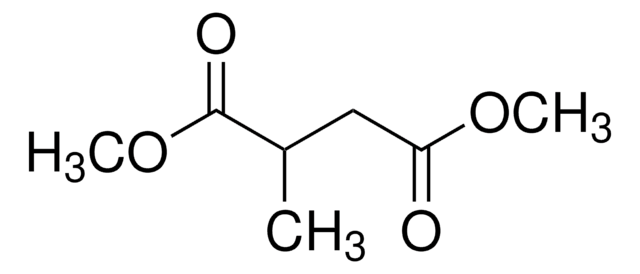W239607
Dimethylsuccinat
98%, FG
Synonym(e):
Dimethylbutandioat, Bernsteinsäure-Dimethylester
About This Item
Empfohlene Produkte
Biologische Quelle
synthetic
Qualitätsniveau
Qualität
FG
Halal
Kosher
Einhaltung gesetzlicher Vorschriften
EU Regulation 1334/2008 & 178/2002
FDA 21 CFR 117
FDA 21 CFR 172.515
Dampfdruck
0.3 mmHg ( 20 °C)
Assay
98%
Selbstzündungstemp.
689 °F
Expl.-Gr.
8.5 %
Brechungsindex
n20/D 1.419 (lit.)
bp
200 °C (lit.)
mp (Schmelzpunkt)
16-19 °C (lit.)
Dichte
1.117 g/mL at 25 °C (lit.)
Anwendung(en)
flavors and fragrances
Dokumentation
see Safety & Documentation for available documents
Nahrungsmittelallergen
no known allergens
Organoleptisch
green; fruity; floral; sweet
SMILES String
COC(=O)CCC(=O)OC
InChI
1S/C6H10O4/c1-9-5(7)3-4-6(8)10-2/h3-4H2,1-2H3
InChIKey
MUXOBHXGJLMRAB-UHFFFAOYSA-N
Suchen Sie nach ähnlichen Produkten? Aufrufen Leitfaden zum Produktvergleich
Verwandte Kategorien
Allgemeine Beschreibung
Anwendung
- Metabolic Bypass Rescues Aberrant S-nitrosylation-Induced TCA Cycle Inhibition and Synapse Loss in Alzheimer′s Disease Human Neurons.: This research discusses the role of metabolic intermediates like Dimethyl succinate in bypassing biochemical blocks in Alzheimer′s disease, offering potential therapeutic avenues (Andreyev et al., 2024).
- Update to RIFM fragrance ingredient safety assessment, dimethyl succinate, CAS Registry Number 106-65-0.: A comprehensive safety assessment of Dimethyl succinate as a fragrance ingredient, highlighting its toxicological profile and safe usage parameters (Api et al., 2023).
Signalwort
Warning
H-Sätze
P-Sätze
Gefahreneinstufungen
Eye Irrit. 2
Lagerklassenschlüssel
10 - Combustible liquids
WGK
WGK 1
Flammpunkt (°F)
201.2 °F - closed cup
Flammpunkt (°C)
94 °C - closed cup
Persönliche Schutzausrüstung
Eyeshields, Gloves, type ABEK (EN14387) respirator filter
Analysenzertifikate (COA)
Suchen Sie nach Analysenzertifikate (COA), indem Sie die Lot-/Chargennummer des Produkts eingeben. Lot- und Chargennummern sind auf dem Produktetikett hinter den Wörtern ‘Lot’ oder ‘Batch’ (Lot oder Charge) zu finden.
Besitzen Sie dieses Produkt bereits?
In der Dokumentenbibliothek finden Sie die Dokumentation zu den Produkten, die Sie kürzlich erworben haben.
Kunden haben sich ebenfalls angesehen
Unser Team von Wissenschaftlern verfügt über Erfahrung in allen Forschungsbereichen einschließlich Life Science, Materialwissenschaften, chemischer Synthese, Chromatographie, Analytik und vielen mehr..
Setzen Sie sich mit dem technischen Dienst in Verbindung.











